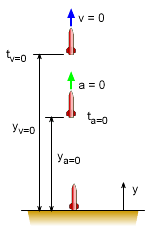| Ch 1. Particle General Motion | Multimedia Engineering Dynamics | ||||||
|
Position, Vel & Accel. |
Accel. vary w/ Time |
Accel. Constant | Rect. Coordinates | Norm/Tang. Coordinates | Polar Coordinates |
Relative Motion |
|
| Position, Velocity, Acceleration | Case Intro | Theory | Case Solution | Example |
| Chapter |
| - Particle - |
| 1. General Motion |
| 2. Force & Accel. |
| 3. Energy |
| 4. Momentum |
| - Rigid Body - |
| 5. General Motion |
| 6. Force & Accel. |
| 7. Energy |
| 8. Momentum |
| 9. 3-D Motion |
| 10. Vibrations |
| Appendix |
| Basic Math |
| Units |
| Basic Dynamics Eqs |
| Sections |
| eBooks |
| Dynamics |
| Fluids |
| Math |
| Mechanics |
| Statics |
| Thermodynamics |
| ©Kurt Gramoll |
|
|
||
 Toy Rocket |
Example |
|
|
A small toy rocket follows a vertical path that can be modeled by y(t) = 5t3/6 - t4/12 (ft). What will be the maximum height? Also, what is the height when the acceleration is zero?
|
||
| Solution |
||
|
|
First, find the equation that models both the velocity and acceleration as function of time. v(t) = dx/dt = 5t2/2 - t3/3 a(t) = dv/dt = 5t - t2 a) The maximum height will occur when velocity is zero (it has reached it zenith). v = 0 = 5t2/2 - t3/3 Substitute time back into the position equation gives, yt=7.5 = 5 (7.5)3/6 - (7.5)4/12 b) Use the acceleration equation to find the time when the acceleration will be zero. a = 0 = 5t - t2 Substitute time back into the position equation gives, yt=5.0 = 5 (5)3/6 - (5)4/12 So, the rocket has a negative acceleration after the rocket goes up only 52.08 ft, but it keeps climbing until it reaches its zenith of 87.89 feet. |
|
